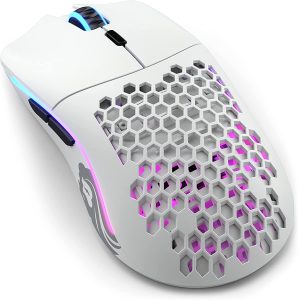When it comes to gaming, precision, speed, and reliability are crucial. One critical aspect often overlooked is click latency—the delay between clicking a mouse button and the corresponding action registering in your game. But does click latency matter in gaming mice?
Let’s explore why it’s significant and how it impacts gaming performance.
What is Click Latency?

Click latency is the time delay between the physical click of a mouse button and the corresponding action being performed on the screen. In gaming, this delay can have a significant impact on the player’s performance, especially in competitive gaming.
For example, in first-person shooter games, the delay between clicking the mouse button to shoot and the action being performed on the screen can mean the difference between winning or losing.
Several factors can affect click latency, including the hardware and software used, the connection type, and the computer’s processing speed. Gaming mice designed for competitive gaming usually have low click latency to provide a fast and responsive gaming experience.
These mice often use mechanical switches that require less force to click and have a faster response time than traditional membrane switches. Some gaming mice also have customizable click latency settings, allowing players to adjust the response time to their preference.
Why Does Click Latency Matter in Gaming Mice?

Click latency may seem like a minor detail when it comes to gaming, but it can have a significant impact on a player’s performance. Here are some reasons why click latency matters in gaming:
Faster Response Time
In competitive gaming, every millisecond counts, and having a low click latency can give players a significant advantage. With faster response times, players can react quicker to in-game events, such as enemy movements or firing their weapons. This can mean the difference between winning or losing.
Accuracy and Precision
Click latency can also affect a player’s accuracy and precision in games. When playing games that require aiming, such as first-person shooters, a high click latency can result in the player missing their target. A low click latency can improve accuracy and precision, allowing players to hit their targets more consistently.
Consistency
Consistency is crucial in competitive gaming, and a high click latency can make it difficult for players to perform consistently. When a player’s actions are delayed due to high click latency, their movements can become unpredictable, making it harder to execute strategies and play effectively.
Comfort and Convenience
Low click latency can also make gaming more comfortable and convenient for players. When a mouse has a low click latency, players can perform actions with less effort, reducing the strain on their fingers and wrists. This can make long gaming sessions more comfortable and less tiring.
Overall Gaming Experience
Click latency can affect the overall gaming experience, and high click latency can make gaming feel sluggish and unresponsive. Low click latency can make gaming more enjoyable, immersive, and engaging.
Also Read: How Many Clicks Per Second Is Considered Fast?
Factors that Affect Click Latency

Click latency is influenced by several factors, both hardware and software, that can impact a player’s gaming experience. Here are some of the factors that affect click latency:
Switch Type: The switch type used in a gaming mouse can have a significant impact on click latency. Mechanical switches are often preferred for gaming mice due to their faster response times compared to traditional membrane switches. The amount of force required to activate the switch can also affect click latency, with lighter switches generally having lower latency.
Firmware and Software: The firmware and software used in a gaming mouse can affect its click latency. Some gaming mice have the built-in processing power to reduce latency, while others rely on software to optimize performance. Outdated firmware or software can lead to higher click latency, making it essential to keep them up-to-date.
Connection Type: The connection type between the gaming mouse and the computer can also affect click latency. Wired connections generally have lower latency than wireless connections, although newer wireless technologies such as Bluetooth 5.0 and 2.4GHz wireless can offer low latency.
Polling Rate: The polling rate of a mouse refers to how often it reports its position to the computer. A higher polling rate can reduce click latency, as the computer receives more frequent updates from the mouse. Most gaming mice have a polling rate of 1000Hz, which provides a low-latency gaming experience.
Processor Speed: The speed of the computer’s processor can also affect click latency. Slow processors can cause delays in processing mouse inputs, leading to higher click latency. Upgrading the computer’s processor can help reduce latency and improve overall gaming performance.
Operating System: The operating system used can affect click latency, with some operating systems having better support for gaming mice than others. Windows, for example, has a built-in feature called “Enhance Pointer Precision” that can introduce mouse acceleration and affect click latency. Disabling this feature can help reduce latency.
How Much Latency Is Acceptable?
For casual gamers, a latency of 10-15ms is usually acceptable. However, competitive gamers typically prefer mice with click latency under 5ms to ensure maximum responsiveness.
How to Test Click Latency
You can test your gaming mouse’s latency using tools like MouseTester or by comparing it to other mice using professional reviews and benchmarks. Additionally, some games have built-in tools to measure input lag.
How to Choose a Gaming Mouse with Low Click Latency

A good click latency for a gaming mouse is typically less than 10ms. Lower latency can provide faster response times, improved accuracy, and a more comfortable gaming experience.
Can I reduce click latency on my current gaming mouse?
Reducing click latency on a current gaming mouse may be possible by updating the firmware and software, adjusting the polling rate, and disabling any unnecessary features that can introduce latency. However, the hardware limitations of the mouse may prevent it from achieving the lowest latency possible.
Is wireless or wired gaming mice better for low click latency?
Wired gaming mice generally have lower click latency than wireless gaming mice. However, newer wireless technologies such as Bluetooth 5.0 and 2.4GHz wireless can offer low latency and provide a comparable experience to wired gaming mice.